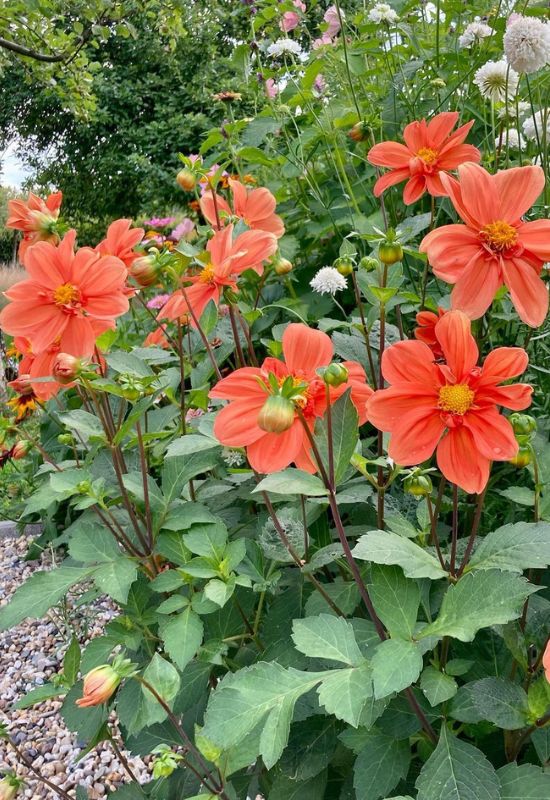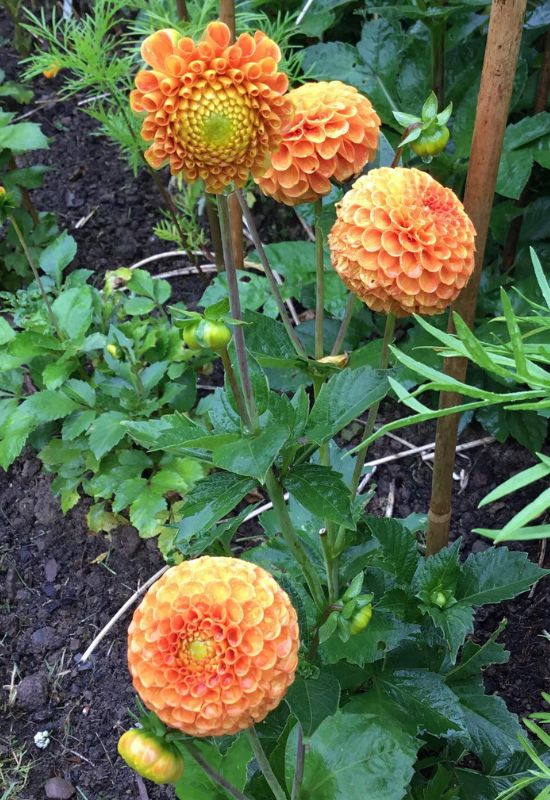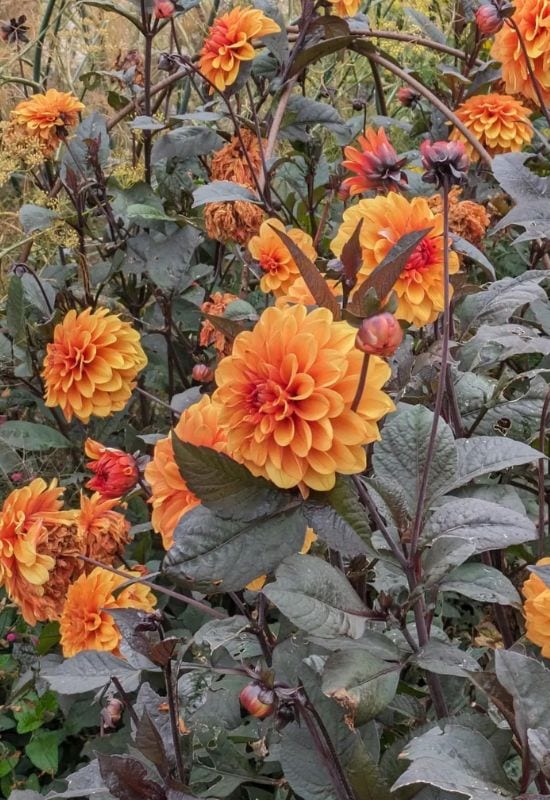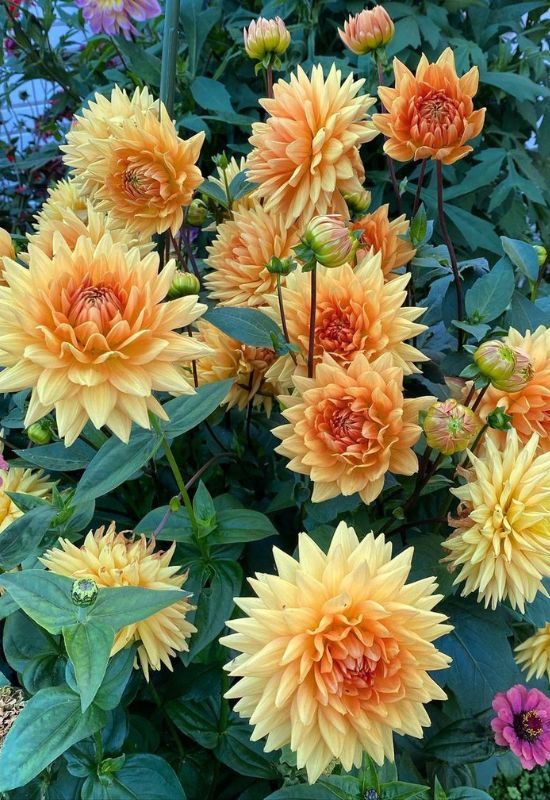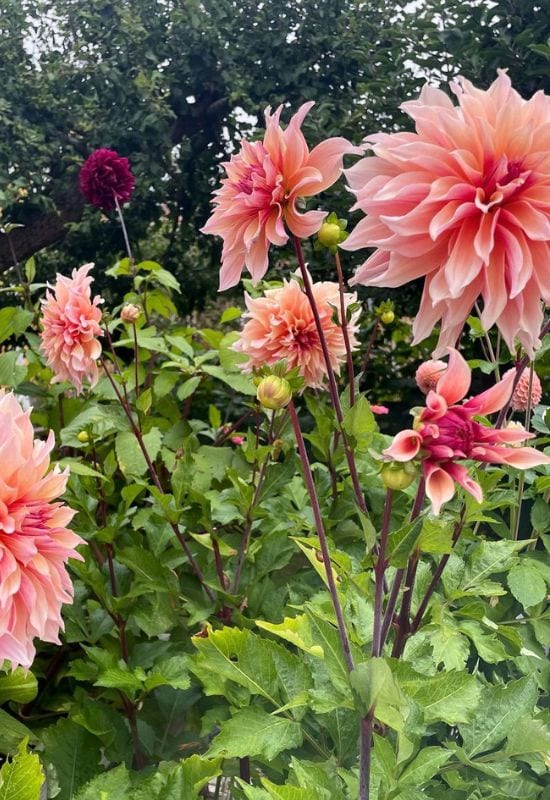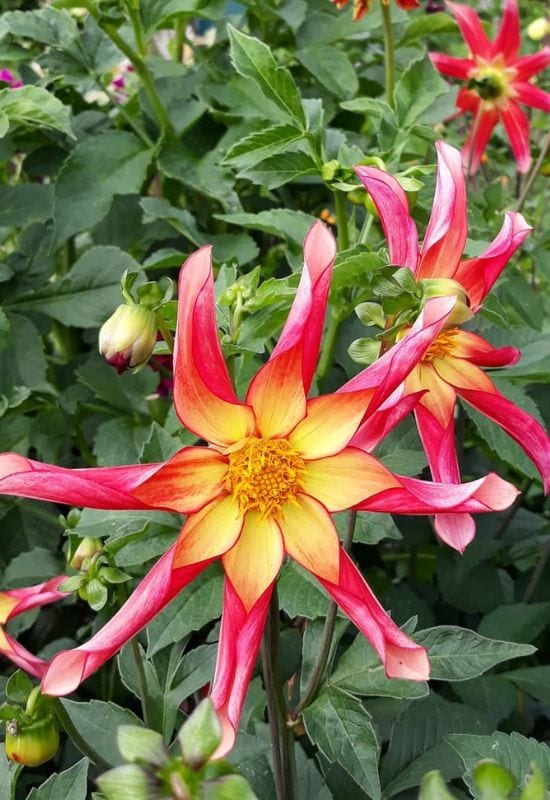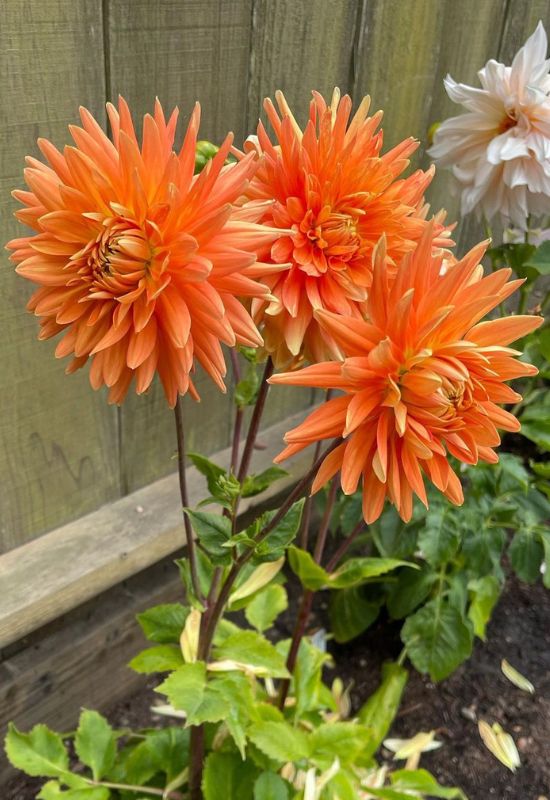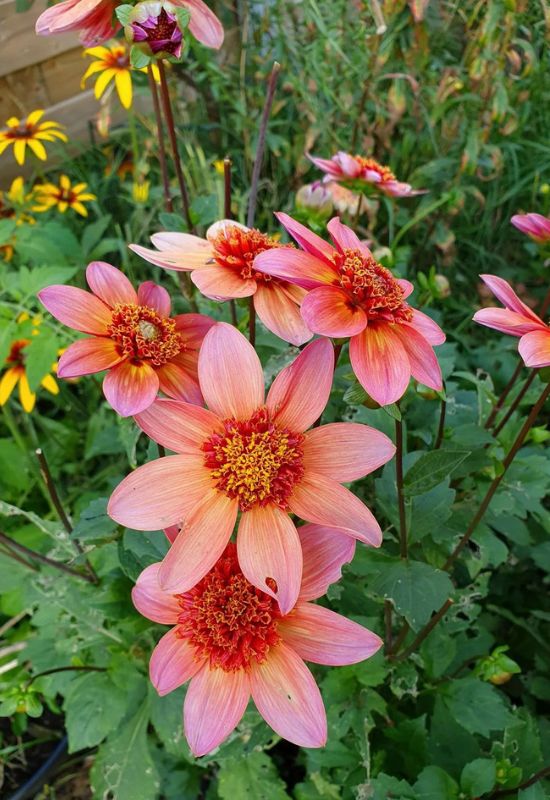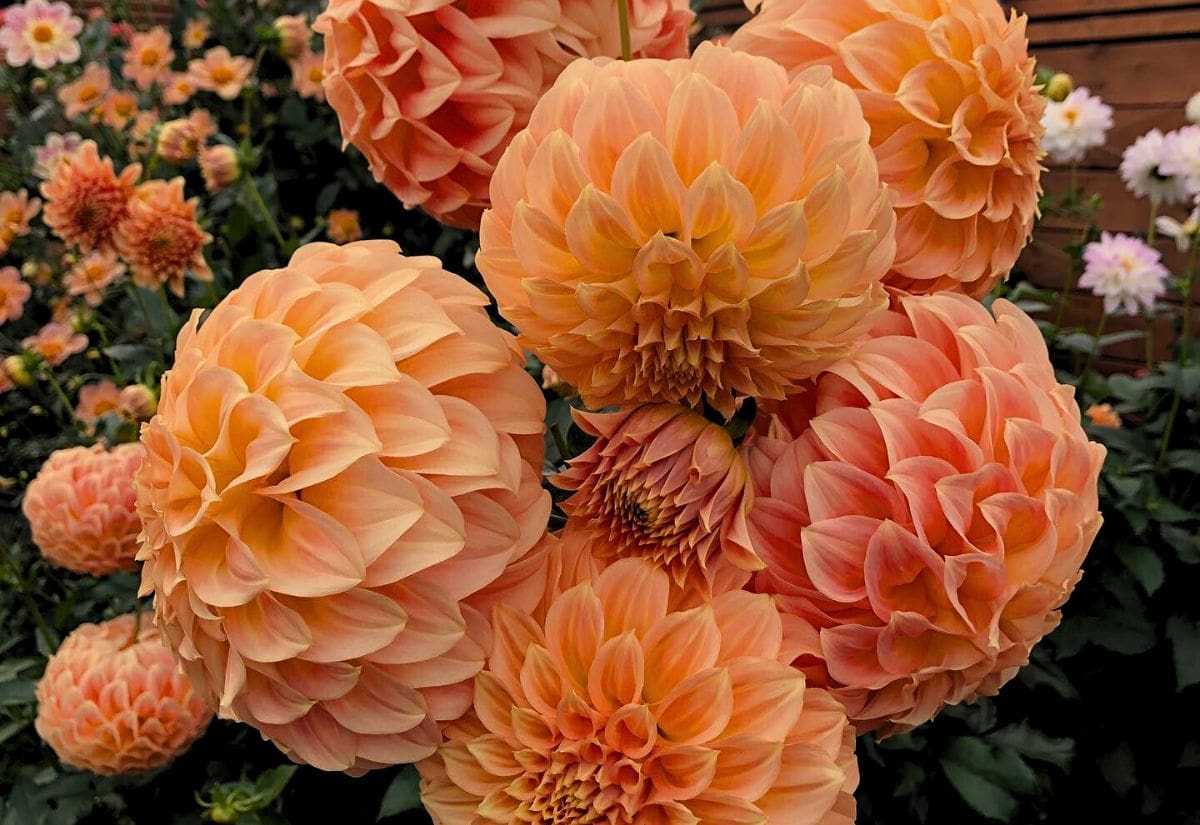
If you’re dreaming of keeping your garden, borders, and flower beds lively and vibrant all the way through the season, you’re in for a treat with the idea I have for you—why not bring some orange-flowered dahlia varieties into your green space? Maybe even play around with a few different kinds!
Their showy and long lasting blossoms in strong tangerine or carrot, or soft mango and peach will bring light but also warmth, depth and happiness to your summer and fall days, and lush and dense foliage will fill gaps and keep your green haven fresh till frost…
These tuberous flowering perennial queens follow the course of the Sun from its apex to when it is low on the horizon, and reflect the colors of hot summers and mellow fall, but their blooms also come in many shapes…
You’ve got choices galore—from single and double cultivars, to cactus and semi-cactus varieties, right down to pompon, decorative dinner plate, water lily, peony-shaped, collarette, and anemone flowered types. The visuals are a delight, and with a splash of orange, they command a second look, always!
I know, with such a vast range (there are thousands of varieties, literally!), it might feel like searching for that proverbial needle in a haystack when picking out the dahlias with bright orange flowers that tug at your heart. But hey, that’s where I step in! I’ve handpicked some of the finest orange dahlias from each category just for you.
14 Dahlia Varieties With Orange Flowers That Will Paint Your Garden With Warmth
And here they are… All these varieties have one thing in common: they are orange, but they all vary in tonality, size and even the shape of the blossoms!
And I can start with a really showy giant dahlia variety with such massive orange blooms that you can see them from a distance!
1: ‘Hart’s Autumn Splendor’ Semi Cactus Dahlia (Dahlia ‘Hart’s Autumn Splendor’)
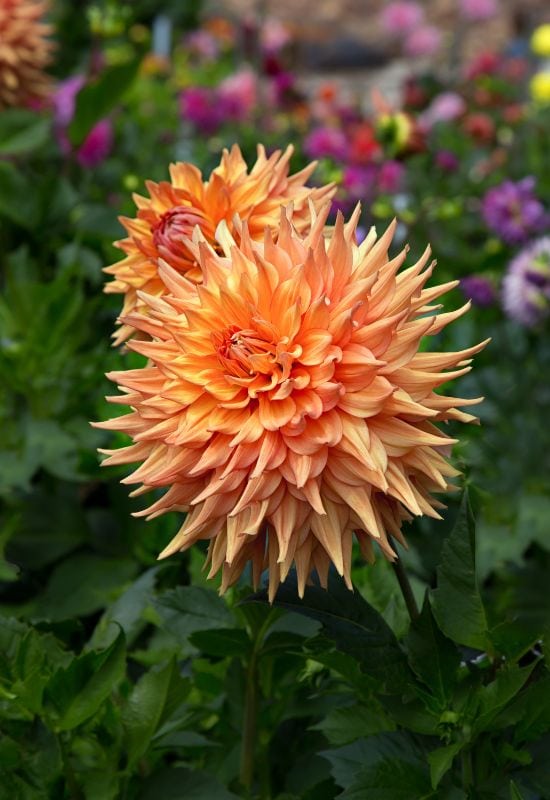
For a wild and explosive effect in your garden, you may like ‘Hart’s Autumn Splendor’, a semi cactus variety with a really impressive floral display. Its blooms will start in July and only end with the first day of frost, and they are really impossible to miss…
In fact, they are a whopping 8 to 10 inches across (20 to 25 cm!) and they have a wild look on them… The petals of the fully double flowers are elongated, and partly furled lengthways, like the rays of the Sun itself.
This gives you a very dynamic and energetic effect, which is then, this is heightened by the vibrant coloring it displays. Starting bright orange (carrot to fire) at the tips, it slowly lights up to a bright golden yellow in the center, and it does it with such decorative dashes and fading that it looks like it has been painted by an Impressionist Master.
This is the orange dahlia variety that Van Gogh would have loved. Of course, all this is accompanied by lush, dented foliage, on the bright green size.
Add a rebellious but also fiery touch to your borders or containers with ‘Hart’s Autumn Splendor’ semi cactus dahlia, and it also has very long and sturdy stems, which makes it an outstanding cut flower!
2: ‘G. F. Hemerik’ Single Mignon Dahlia (Dahlia ‘G. F. Hemerik’)
But maybe you are looking for a more delicate effect for your summer and fall garden? Then you may try ‘G. F. Hemerik’ a sweet looking single mignon dahlia. In fact, its flowers are “small” (as dahlias go…) at “only” 3.2 inches across (8.0 cm), with 8 broad elliptical petals with a soft tip, and a little golden yellow center.
With lovely undulation that runs lengthways, the blooms display one of the most delicate shades of orange you will ever see, on the light apricot range, usually, but sometimes they also take on exquisite peach and even salmon tonalities.
They come on thin and upright purple stems, attracting lots of butterflies and pollinators, and popping up above the foliage below, which is on the dark side, and lance shaped, but broad and dented. This mound, however, is quite low, as this is a compact variety.
Ideal for a traditional and romantic looking green space, like a cottage or English country garden, ‘F. G. Hemerik’ single mignon dahlia is not a good cut flower, given its weak stems, but it can give you a suave and elegant presence till late in the season, with mellow feelings. Grow it in s a sheltered position, as it won’t tolerate strong winds, and mass plant it for best effects in an herbaceous border or flower bed.
3: ‘Bantling’ Pompon Dahlia (Dahlia ‘Bantling’)
Now, orange is a strong vibrant and energetic color, and you may want some of it in your garden, but maybe you don’t want it to take over from other shades? And maybe you also want a really striking floral shape in your border… Enter ‘Bantling’ a small flowered pompon variety, which hits to striking but also self balancing notes.
In fact, the blooms are not big, only up to 3 inches across (7.5 cm), but they are of an impressively powerful fire orange shade, almost touching pale red… This gives you eye catching visual points, but then you also get its other main trait… The fully double blossoms are spherical, and the petals furled upwards, forming very geometric pointed spoons that collect the morning brine.
What is more, they are perfectly arranged, with the sculptural quality of a little work of art… Some heads may be brighter in tonality as well, and this can give you some variation within the same theme. Coming on slender purple stems, they hover above the dense foliage, with deeply dented, almost loved leave that can be mid or dark green.
An ideal choice for herbaceous borders and if you mass pompon it, ‘Bantling’ is a popular variety of pompon dahlia with a decided orange shade, and you could grow it for cut flowers, though the stems are weak, or just enjoy the sculptural value of its blossoms outdoors. It will suit all informal garden styles.
4: ‘Kesley Annie Joy’ Collarette Dahlia (Dahlia ‘Kesley Annie Joy’)
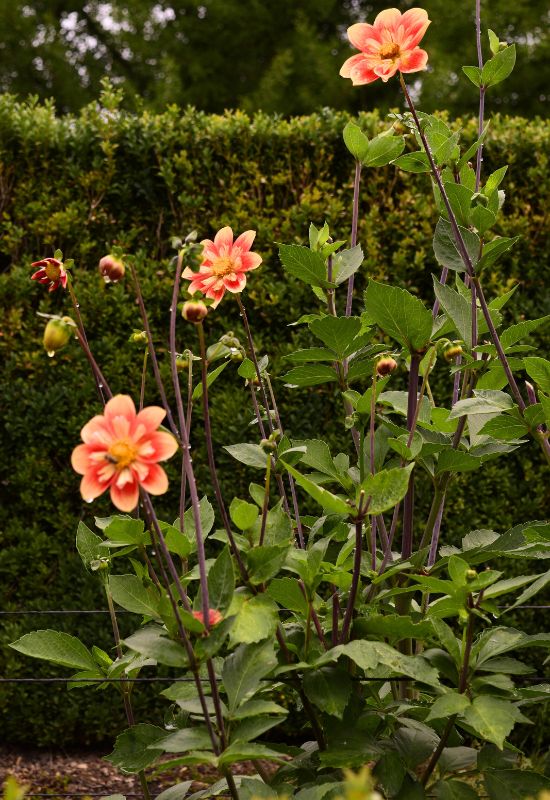
Yet another transformation of this beautiful tuberous perennial takes the name of ‘Kesley Annie Joy’. Now, there are not many collarette varieties in our color, and this is the most popular and convincing.
The flowers are not large up to 4 inches across (10 cm), but they can even be half this size… Anyway, they are really attractive, with broad, flat and fully open petals, almost rounded at the tips.
These can be of a pale shade of orange, along the marigold to apricot range, with peach blushes as well, but they can sometimes tend towards soft pink shades as well, you may need to take a risk… But, being of the collarette category, it also has an inner ring of smaller ones (called petaloids), and these are of brighter tonalities, drawing your eye in towards the golden disk in the center.
On them, you could will usually see notes of pink to deep rose, even magenta in some cases. Here’s another favorite with butterflies and bees, that will buzz over the blossoms that rise up above the dense, dented, lance shaped and really dark green foliage below.
Elegant and original looking, ‘Kensley Annie Joy’ collarette dahlia will bring a very refined and sophisticated effect to your flower beds and borders. It too works best if mass or group planted and if you keep it sheltered from strong winds.
5: ‘David Howard’ Decorative Dahlia (Dahlia ‘David Howard’)
And now we come to a real champion: ‘David Howard’ dahlia is a winner of the most prestigious gardening prize of all, the Award of Garden Merit by the Royal Horticultural Society, as well as 26 other awards!
And I can tell you why… This decorative variety has fully double blossoms of about 4 inches in diameter (10 cm) and packed with many slightly cupped petals that give them structure and depth.
The flowers that appear in mid summer are of a very vibrant and luminous apricot orange color, and they will keep so through most of the season. However, later in the year, they will take on pinkish blushes, and the last blooms may even be fully pink.
Coming on long, upright and sturdy purple stems, this floral display also benefits from a striking contrast with the plant’s foliage. In fact, the lance shaped and dented leaves are of an extremely dark greenish purplish shade, tending to tan and bronze.
One of the best varieties for cut flowers, ‘David Howard’ decorative dahlia is an extremely popular cultivar, also for herbaceous borders, and being suitable to virtually all informal garden styles, it will certainly look great in yours as well!
6: ‘Scura’ Single Mignon Dahlia (Dahlia ‘Scura’)
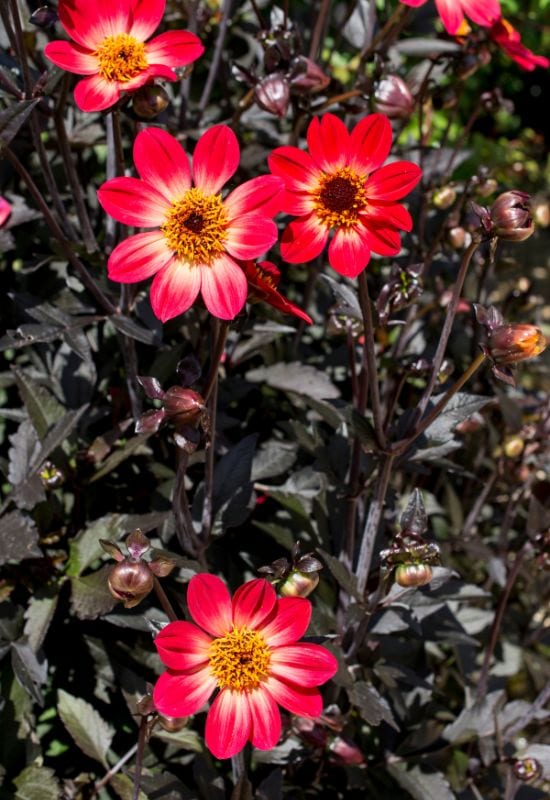
And we dome to a really mignon variety, ‘Scura’. True, its flowers are actually very small, as is the whole dwarf plant, only 1.2 inches wide (3.0 cm), but don’t be mistaken; what they lack in size, they really make up in color and energy!
These single blossoms, in fact, have lovely rounded petals (with a tiny tip at the end), and they have an exceptional velvet like texture. Opening fully to a a flat bloom, they also have the most intense and deep orange ever: fire to scarlet, and with a vibrancy that’s hard to replicate.
So, if you are into this shade, you will really like this variety! They are also very attractive to butterflies, bees and pollinators, that come to feast on the sweet nectar of this long lasting floral display.
But its name (which means “dark”) also hints at other traits of this perennial… The stems are of the deepest purple ever, and the lance shaped and regularly serrated leaves are semi glossy, and with rich emerald green and dark purple on them.
One of the most intense orange varieties ever, ‘Scura’ is a single mignon dahlia that can bring depth and lots of warmth to a natural looking border front or flower bed, especially if mass planted, and it is a real must have in a cottage garden that needs some energy late in the season.
7: ‘Glorie van Noordwijk’ Decorative Dahlia (Dahlia ‘Glorie van Noordwijk’)
Yet another change and yet another surprise for you from this amazing tuberous perennial! This time we brighten up our mood and go for size with ‘Glorie van Noordwijk’ dahlia, a decorative and fully double variety…
In fact, when its blooms will open in your garden you will be taken aback by their dimensions, up to 8 inches across (20 cm)! With many long and pointed petals, they will definitely take center stage in your borders, and they will also light up your days with the very luminous butterscotch orange color that these blossoms display, which verges on the dark yellow…
Opening continuously on long, sturdy and upright stems, they will definitely lift up any dull composition, and the bright green lance shaped and dented foliage of this cultivar will add a final and yet again luminous touch to the ensemble.
An absolute luminous wonder as a cut flower, ‘Glorie van Noordwijk’ decorative fully double dahlia is a strong, energetic and light filled presence that can shine like a sunny day in herbaceous borders or containers in most informal gardens, especially with a traditional style.
8: ‘Orange Turmoil’ Cactus Dahlia (Dahlia ‘Orange Turmoil’)
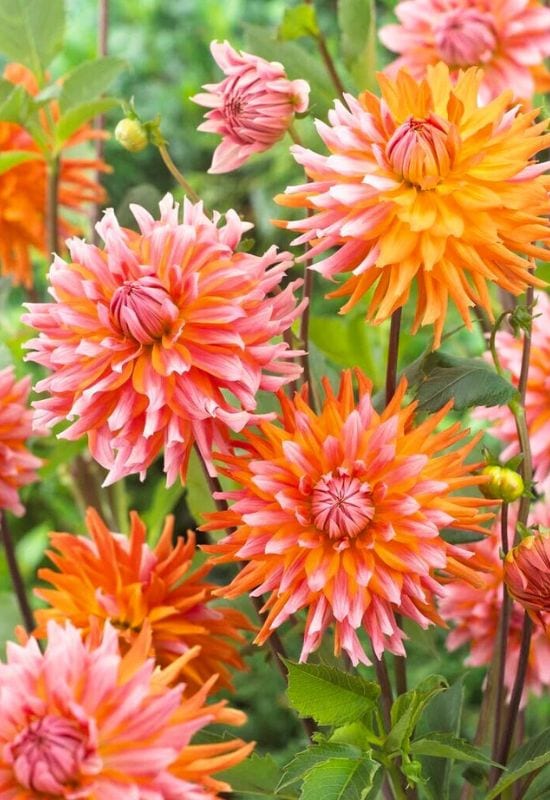
Get ready to be literally blown over! Yes, because ‘Orange Turmoil’ is arguably one of the most striking dahlia varieties ever bred. In fact, this cactus variety is literally puzzling, and a quick look at it will tell you why… But this time, we need to add a little twist…
Its fully double flowers come with their 6 inches in diameter (15 cm) all the way from mid summer to frost, and they display lots of furled petals, that look like rebellious spikes… But the amazing feature of this energetic beauty is that some are super bright orange, on the carrot to tangerine range, while others also have pink, even with rose hues, usually at the tips…
The visual and chromatic chromatic contrast is literally impressive, and these large blossoms come on upright but rather slender stems that bring them above the rich emerald green, semi glossy leaves.
Growing ‘Orange Turmoil’ cactus dahlia in your garden means adding an incredible game of vibrant colors, dynamically shaped large blooms and a sense of… light and playfulness to your flower beds, borders and containers, but you can take this spectacle indoors as cut flowers too.
9: ‘Classic Elise’ Peony Flowered Dahlia (Dahlia ‘Classic Elise’)
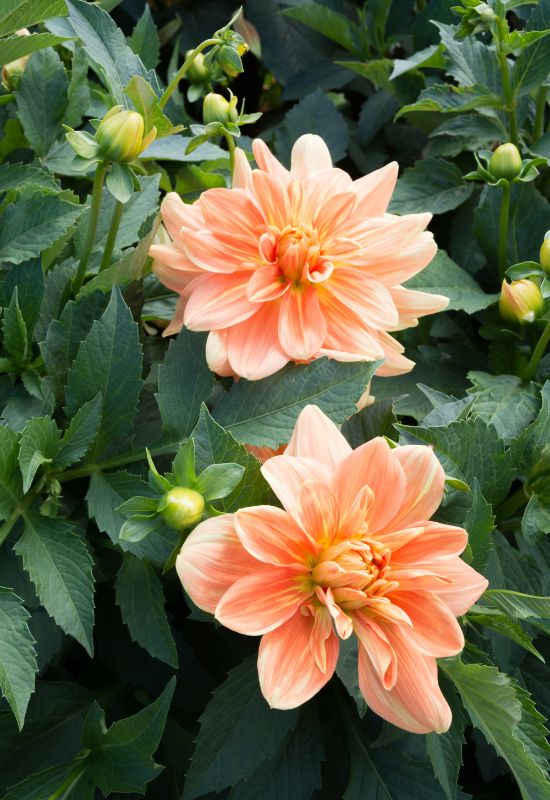
But now it is time for a suave, elegant variety, aptly called ‘Classic Elise’… Its beauty is fully due the soft touch, on the balance, on the delicate charm and harmony of shape and shade of its blooms.
Semi double, the flowers are about 4 inches across, or 10 cm, and they have elliptical petals that start flat and become cupped as you move from the outer ones to the ones, as they also become progressively smaller… And to this, you need to add the bright but pastel color of perfect peach orange that these flowers display from mid summer to frost!
The central tends to be a bit deeper in tonality, but it dutifully respects the theme and monochromatic palette of the blossoms. They will open on purple stems above the foliage, which gives you a spectacular backdrop, adding depth to the floral display with its glossy dark purplish leaves with deep green undertones.
If you want sheer elegance and class in your garden, you will definitely need to grow ‘Classic Elise in your herbaceous borders or containers. A very good cut flower, this peony shaped dahlia will suit all informal designs, including oriental in style, and it could work well even in a formal space.
10: ‘Babylon Bronze’ Dinner Plate Dahlia (Dahlia ‘Babylon Bronze’)
Yet another twist, yet another wonderful and different variety in our color: ‘Babylon Bronze’. This is a fully double dinner plate dahlia cultivar with large blooms, up to 8 inches across (20 cm), and quite spectacular, but unruly indeed… The fact is a that its many long petals don’t seem to take well to formality and geometry…
They partly furl and partly curl slightly; they are longer at the back and shorter in the center… However, the overall effect is quite soft, chiffon like, rather that hirsute or rebellious… And this is also thanks to the soft peach to apricot tonality that the flowers have.
Having said this, like other varieties in pale orange, they may tend to fade to pinkish and even full pink, especially later in the season. Win er of multiple awards, it will also give you a very deep and semi glossy green backdrop, thanks to its dense foliage with leaves that are only gently serrated, almost smooth edged.
Yet another excellent choice for cut flowers, especially in a romantic bouquet, ‘Babylon Bronze’ dinner plate dahlia will bring a touch of soft passion also to your containers of borders, and it will do it for a long time and with a mix of delicacy and irreverence.
11: ‘Honka Orange’ Orchid Dahlia (Dahlia ‘Onka Orange’)
On to an exotic looking and rare variety: ‘Honka Orange’ orchid dahlia… This cultivar is part of a series that has won the Award of Garden Merit by the Royal Horticultural Society, and it is really unusual – in fact, you may hardly recognize it as a member of this e genus!
The flowers have 8 petals, but they look like rays, because they furl onto themselves, forward, and you can see the front side in the middle and the back side on the sides… This gives you a deep fire to tangerine orange central visual strip, and “wings” that instead tend to be paler and acquire peach tonalities!
But what is more, the petals also curl back ever so slightly, and they are clearly parted, hence the reference to orchids. The blossoms are about 4 inches in size (10 cm) and they have a central golden yellow eye that adds light and energy to the blooms.
These come on long and slender reddish purplish stems, that take them up from the dense rich and deep green and gently serrated lance shaped leaves. But if you get closer, you will also notice that they have a slight fragrance as well!
Of course, ‘Honka Orange’ orchid dahlia will work well also in an exotic looking garden, but feel free to grow it in containers, borders of for cut flowers even if your green haven has a far more traditional style, as long as it is informal.
12: ‘Motto’Dinner PlateDahlia (Dahlia ‘Motto’)
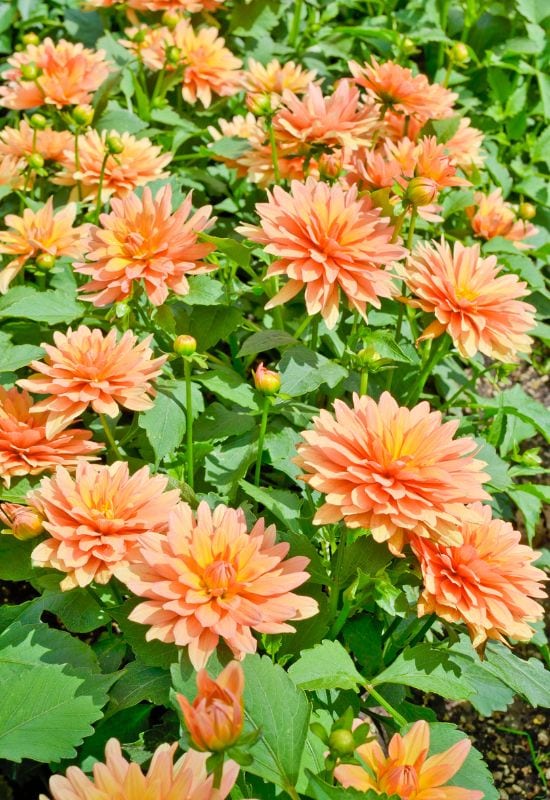
But now I would like to look at a cultivar that really plays with the orange palette, like an experienced artist mixing hues with his or her brush: ‘Motto’. This dinner plate variety is fully double, and with blossoms between 7 and 8 inches in diameter (17.5 to 20 cm).
And you do need a big canvas to get its different tonalities on the long and pointed but also fairly broad and flat petals. In fact, on these flowers you will see a fusion of shades that include peach, apricot, papaya and cantaloupe, all within the orange range, and picking on rare and sophisticated tonalities.
But this light filled painting is not random… Blushing warm and deeper at the margins it turns to honey and then fully golden yellow in the middle. The long and purple stems that hold this colorful floral display brings the blooms above a very rich and darkish emerald green mound of semi glossy lance shaped leaves that, unusually, have smooth edges…
Yet another striking variety for cur flowers, ‘Motto’ dinner plate dahlia hits notes of great sophistication with its color and adds to them really showy flower heads. It is one of the best orange cultivars to grow in a garden where you want a big effect, but you also want to preserve a soft and refined atmosphere.
13: ‘Mrs Eileen’ Decorative Dahlia (Dahlia ‘Mrs Eileen’)
Let’s change again! If ‘Motto’ plays with soft tones, ‘Mrs Eileen’ comes back to remind us of the energy and strength of our color! And it does it with a bang! In fact, this fully double decorative dahlia cultivar has blossoms that reach 8 inches across (20 cm), though the size os slightly variable, and some may be as “small” as 6 inches in diameter (15 cm).
But size is not all you get… The amazing vibrancy of its orange shades is indeed its main asset! And this time, we will find darker and deeper tonalities on the flat, elliptical and velvet textured petals in the center, where the blooms reach high notes of scarlet orange, then they turn fire, then carrot, and so forth, thill you reach the outer parts of the flowers, where this spectacle lightens up to tangerine, then, sometimes even to paler touches of apricot.
This amazing palette makes it one of the most “decidedly orange” varieties you can grow in your garden, and the showy heads come on sturdy purplish stems that emerge from the dense foliage below.
As a final touch, the deeply serrated lance shapedleaves have a particularly bright and cheerful green color, and with clearly visible veins that give them a rough texture.
‘Mrs Eileen’ is the dahlia variety you want to grow if you really need a huge injection of energy to your mid and late season garden, with its big and eye catching orange blooms and bright foliage, that, again, also make excellent cut flowers.
14: ‘Totally Tangerine’ Anemone Flowered Dahlia (Dahlia ‘Totally Tangerine’)
And we conclude with another shapeshifting trick of this tuberous perennial with many faces: ‘Totally Tangerine’… It is an anemone flowered dahlia cultivar, and there are not many in this category with orange as their color of choice. But its name is a bit misleading, because it is not at all “totally tangerine”, on the contrary… But one thing at a time…
The flowers are medium sized, about 4 inches across, or 10 cm, and they have 8 clearly elliptical petals that spread out fully, starting narrow and then ending in a soft point, almost flat but ever so slightly cupped at close inspection.
And these are not orange! In fact, they have a soft to shell pink shade, though you may see some orange blushes creep in at the base… Then, you have a round and frillydome of petaloids (small petals) the middle, and there you will find the tonalities you are after, in bright shades of carrot, fire, and Guadeloupe and even scarlet.
Some rose may shine through as well, but to add a final touch of brilliance. The floral display blossoms on top of slender purplish stems that rise above the rich and deep green foliage with its gently serrated leaves.
A really special variety, ‘Totally Tangerine’ anemone flowered dahlia will bring a fiery touch of orange in a delicate frame to your containers or herbaceous borders till late in the season, for a complex but also elegant effect, and it too is a great cut flower.
The Complex and Varied World of Orange Flowered Dahlias
This has been a journey not just through the many shades of orange, but also through the many shapes of dahlia blooms. The combination of strong and soft tonalities, small and large blossoms, simple and complex flowers gives you an array of varieties that few perennials offer for a mid and late season vibrant and energetic garden.

Written By
Amber Noyes
Amber Noyes was born and raised in a suburban California town, San Mateo. She holds a master’s degree in horticulture from the University of California as well as a BS in Biology from the University of San Francisco. With experience working on an organic farm, water conservation research, farmers’ markets, and plant nursery, she understands what makes plants thrive and how we can better understand the connection between microclimate and plant health. When she’s not on the land, Amber loves informing people of new ideas/things related to gardening, especially organic gardening, houseplants, and growing plants in a small space.

